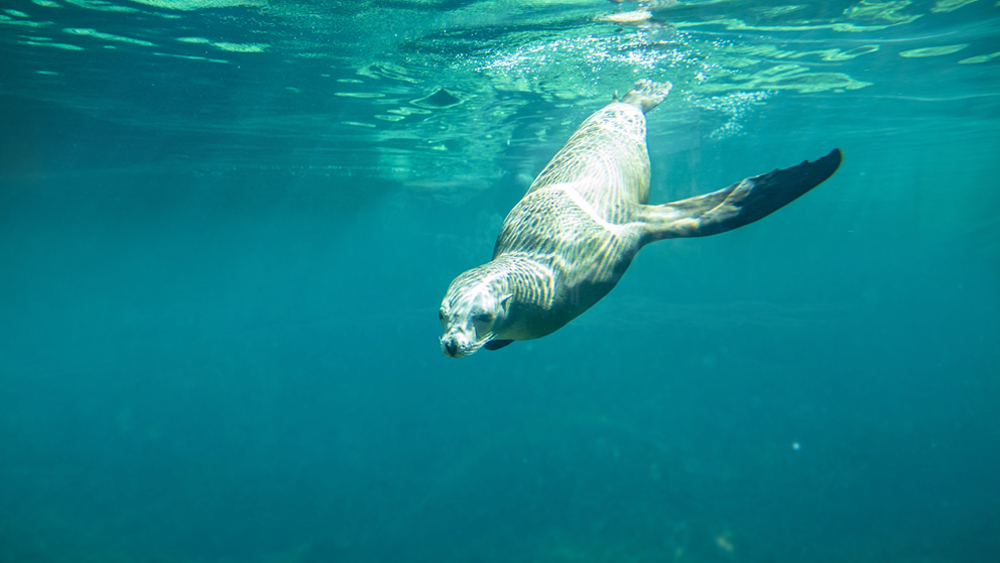While you’re reading this, hold your breath. What is now happening is your blood is delivering the last of oxygenated blood cells to your tissues while carbon dioxide is rapidly building up (hypercapnia). At the same time, there is a steady decrease of blood oxygen (hypoxia). The pH of your blood is getting slightly lower (acidic), and your heart starts to beat faster. God designed your brain to sense the increased carbon dioxide levels and initiates the effort for you to breathe. This will last for about a minute before there will be an involuntary intake of air via the contraction of your diaphragm.
Most people know that seals are mammals, warm-blooded animals with hair, mammary glands, and who give birth to live young. There are many fascinating aspects to these amazing aquatic creatures. One of the more astounding facets is the seal’s ability to dive deep and stay submerged for upwards of 30 minutes.
The world’s deepest-diving mammal is Cuvier’s beaked whale, which can go down over nine thousand feet and stay there for well-over three hours.
“Their deep dives average about 1,400 meters, lasting about an hour, while they are feeding near the sea floor. They typically only spend about two minutes at the surface between dives,” said Jeanne Shearer, a doctoral student in ecology at Duke University’s Nicholas School of the Environment. “It’s amazing that they can dive to such depths, withstand the pressure, and be down there that long, with such brief recovery times.”1
Creationists recognize the design of diving mammals (including sea otters, pinnipeds, cetaceans, and manatees) put in place by Jesus the Creator.2 It’s not so simple for them to just hold their breath while they dive until coming back up for air. Zoologists realized decades ago there is a significant amount of physiological and anatomical features within the creatures that are critical during a typical dive. Such designs could never come about by chance, time, and natural processes.
Take, for example, oxygen storage during the seal’s dive. In addition to oxygen being briefly kept in hemoglobin molecules in the blood,3 a small amount of oxygen is also in the residual air kept in the lungs. (On prolonged dives, some mammals rely on anaerobic respiration that results in a buildup of lactic acid). But this is not why they can stay down so long. God placed a molecule in the muscle called myoglobin. This differs from hemoglobin in that it has a single polypeptide chain (hemoglobin has four peptide chains). The concentration of myoglobin in Cetaceans, pinnipeds, and other marine mammals is about 30 times more than in land animals. The muscle in cattle is bright red (think fresh ground beef), but the oxygen-rich myoglobin concentration in whale and seal muscle is so high it’s almost black, allowing them to stay submerged for so long.
Additionally, an increase of carbon dioxide (CO2) levels in the blood triggers the need to breathe in people and terrestrial animals. This causes the brain’s respiratory center (the medulla oblongata and pons in the brainstem) to increase the depth and rate of breathing. But this is not the case for marine mammals such as seals.
Recently, an article published in Science magazine discussed why seals don’t drown when they forage underwater. In the summary, editor Sacha Vignieri stated, “Marine mammals have adapted to an underwater environment and spend long periods of time underwater foraging despite the need for breathing air.”4 This is basically what creationists would say, although we would state that marine mammals have always been marine mammals and are designed for their underwater environment.
Because these aquatic animals spend extended time under water, they are susceptible to low blood oxygen levels. So God did not design them to sense levels of carbon dioxide in the blood as people and terrestrial mammals do; rather, they are designed to alter their “dives based upon direct perception of oxygen.”4
This oxygen-sensing ability is an excellent engineering design by the Master Engineer, the Lord Jesus. However, evolutionists maintain that the animals perceiving oxygen have “been strongly selected for.”4 Not only does this phrase not identify the selector, but it also presupposes there were untold numbers of aquatic mammals in the past that were not strongly selected for and thus perished. Of course, there is no record of this long selective process. We just have marine mammals today that are exquisitely designed for living in the oceans.
McKnight et al. found through experimentation on pinnipeds with inhaled gas mixes that the seals’ “dive duration was positively correlated with circulating oxygen levels but unaffected by carbon dioxide levels and pH.”4 Because of these results, the zoologists suggest that the “seals do cognitively perceive circulating oxygen and use this to alter dive behavior.”4
Where people and terrestrial mammals are designed with cognitive perception of elevated CO2 as an essential survival trait, aquatic mammals “have a unique ability to cognitively perceive [oxygen] levels in their blood so as to not run out and drown.”5 People are unable to do this because they don’t need to. Evolution has nothing to do with these two clearly designed abilities.
What was the origin of the seals (pinnipeds)? As with all major animal groups, evolutionists don’t know. “All pinnipeds, including both fossil and recent taxa, are diagnosed by a suite of derived morphological characters [having advanced traits], although some of these traits have been modified or lost secondarily in later-diverging taxa.”6 Evolutionist Allaby states the Pinnipedia “families may not be related closely, the classification being based on similarities of appearance and way of life that may result from convergence”7 But convergence, states the late Tom Bethell, “doesn’t fit into the accepted evolutionary scheme” and “creates problems for Darwinism.”8 Indeed, just a year ago an evolutionist stated, “Paleontologists are still piecing together how otter-like creatures related to bears evolved into these amphibious marine mammals [pinnipeds].”9
Seals have always been seals.10 The Bible states that on Day 5 of the creation week God created fish and the aquatic mammals such as cetaceans (whales, dolphins, and porpoises) and pinnipeds (sea lions, seals, and walruses). Such mastery of deep-sea adaptations has remained predominantly unchanged for ~6,000 years.
“Thou, even thou, art LORD alone; thou hast made heaven, the heaven of heavens, with all their host, the earth, and all things that are therein, the seas, and all that is therein, and thou preservest them all; and the host of heaven worshippeth thee”11
References
- Beaked Whales’ Incredible Diving Abilities Confirmed. Duke University. Posted on sciencedaily.com February 6, 2019.
- Acts 14:15.
- Sherwin, F. 2018. Phenomenally Designed Hemoglobin. Acts & Facts. 47 (8): 10–12.
- McKnight, J. et al. 2025. Cognitive Perception of Circulating Oxygen in Seals Is the Reason They Don’t Drown. Science. 387 (6740): 1276–1280.
- Cullen, L. Scientist Discovers Why Seals Do Not Drown While Diving. BBC. Posted on bbc.com March 20, 2025.
- Berta, A. et al. 2018. The Origin and Evolutionary Biology of Pinnipeds: Seals, Sea Lions, and Walruses. Annual Review of Earth and Planetary Sciences. 46: 203–228.
- Allaby, M. 2020. Oxford Dictionary of Zoology. Oxford: Oxford University Press, 473.
- Bethell, T. Darwin’s House of Cards. Seattle, WA: Discovery Institute, 115, 117.
- Black, R. Why Did Seals and Sea Lions Never Commit to a Life Fully at Sea? Smithsonian Magazine. Posted on smithsonianmag.com March 20, 2024.
- Sherwin, F. 2009. No Seal of Approval for Evolution. Acts & Facts. 38 (6): 16.
- Nehemiah 9:6.
* Dr. Sherwin is a news writer at the Institute for Creation Research. He earned an M.A. in invertebrate zoology from the University of Northern Colorado and received an honorary doctorate of science from Pensacola Christian College.





















